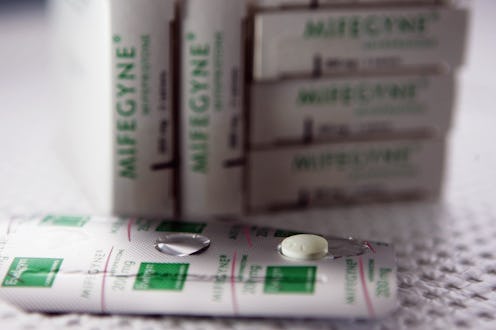News
Oklahoma's New Abortion Law Is Dangerous For Women
If a state is going to shut down most of its abortion clinics, you'd think it would increase access to telemedicine abortion for women living outside metropolitan areas. State officials in Oklahoma, however, seem intent on making it harder and harder for women to obtain an abortion. An Oklahoma judge upheld a ban on abortion-inducing drugs on Wednesday, essentially blocking all telemedicine abortions in the state. The law, HB 2684, also limits medication abortions — a.k.a. the abortion pill — at seven weeks, rather than the commonly practiced nine weeks of pregnancy. This is all in the name of "women's health" — but will the law actually help Oklahoma women seeking abortions?
Anti-abortion legislators in Oklahoma have been sparking controversy over abortion-inducing drugs for quite some time. In 2013, the state's original ban on medication abortions made its way to the Supreme Court, which dismissed the case. In doing so, the Supreme Court let the lower court's ruling invalidating the law stand. The lower court had determined that the initial law would essentially ban the use of all abortion-inducing drugs, such as the commonly used Mifeprex (RU-486), which was unconstitutional.
So, Oklahoma legislators went back to the anti-choice drawing board and came up with a new tactic: Instead of banning the abortion pill altogether, ban how it's most practiced by doctors.
FDA Rules vs. Doctors' Orders
Under Oklahoma's new abortion restriction, abortion providers can only administer the abortion pill according to FDA rules. That should mean it's safe and in the interest of women's health, right? Well, not necessarily. Reproductive rights advocates argued in court that the FDA guidelines for administering the abortion pill are outdated and, in turn, medically invalid. "This [Oklahoma] law is contrary to protecting women's health and will force doctors to use an outdated and less safe medical procedure," Autumn Katz, staff attorney for the Center for Reproductive Rights, said in a statement.
Here's how the FDA guidelines work: Patients must meet with the abortion provider, in-person, on three separate occasions. Despite its name, the abortion pill is a two-pill process, requiring a dose of mifepristone, and then a dose of misoprostol two days later. For both oral doses, the abortion provider must be in the same room as the patient. Then 14 days later, the patient must return to the clinic for a follow-up ultrasound.
However, abortion providers haven't followed these guidelines in over a decade. Research from the Guttmacher Institute claims that even in 2001, roughly 83 percent of U.S. abortion providers weren't going by the FDA rules. Instead, abortion providers use "evidence-based" or "off-label" alternatives that work just as well as the FDA guidelines. For example, abortion providers have found that women only need to take the first dose in the clinic, and can take the second one in the comfort of their own homes, according to Guttmacher researchers:
On the basis of these studies, the National Abortion Federation and Planned Parenthood Federation of America published medical standards that allow for alternative Mifeprex regimens that provide numerous advantages to women, including making medication abortion available for an additional two weeks of gestational age and enhancing patient privacy. ... Today, virtually all Planned Parenthood facilities that provide medication abortion services use these evidence-based alternatives.
Why These New Guidelines Work
It might sound crazy to go against FDA rules, but abortion rights advocates claim these alternatives are actually an improvement on reproductive health care — and can help increase abortion access. For starters, it has allowed some abortion providers, including Planned Parenthood of the Heartland in Iowa, to practice telemedicine abortions, which essentially means taking the first dose of the abortion pill via video-conferencing with a physician. In Iowa, where 85 percent of the state's women live in a county without an abortion provider, telemedicine abortions have helped Planned Parenthood better serve rural women, as well as low-income patients, who can't make multiple 500-mile round trip visits to the nearest abortion clinic.
Oklahoma is not too different from Iowa. In fact, it has much less abortion access, putting the state's women in a more dire situation. Oklahoma has just three abortion clinics — two located in or just outside Oklahoma City, and one in Tulsa. Women living outside these areas have to drive up to 150 miles one-way to the nearest abortion clinic; to take the abortion pill under FDA guidelines, that means 900 miles altogether.
But most importantly, the "evidence-based" alternatives have allowed abortion providers to better serve their patients, whether making abortion more accessible to those who can't afford multiple long-distance trips to the clinic or providing a more comfortable experience. According to Tulsa World, about half of the patients at Reproductive Services in Oklahoma City opt for a medication abortion. Now, the clinic expects to see its services — and a woman's right to choose — greatly impacted.
Images: Getty Images (4)
